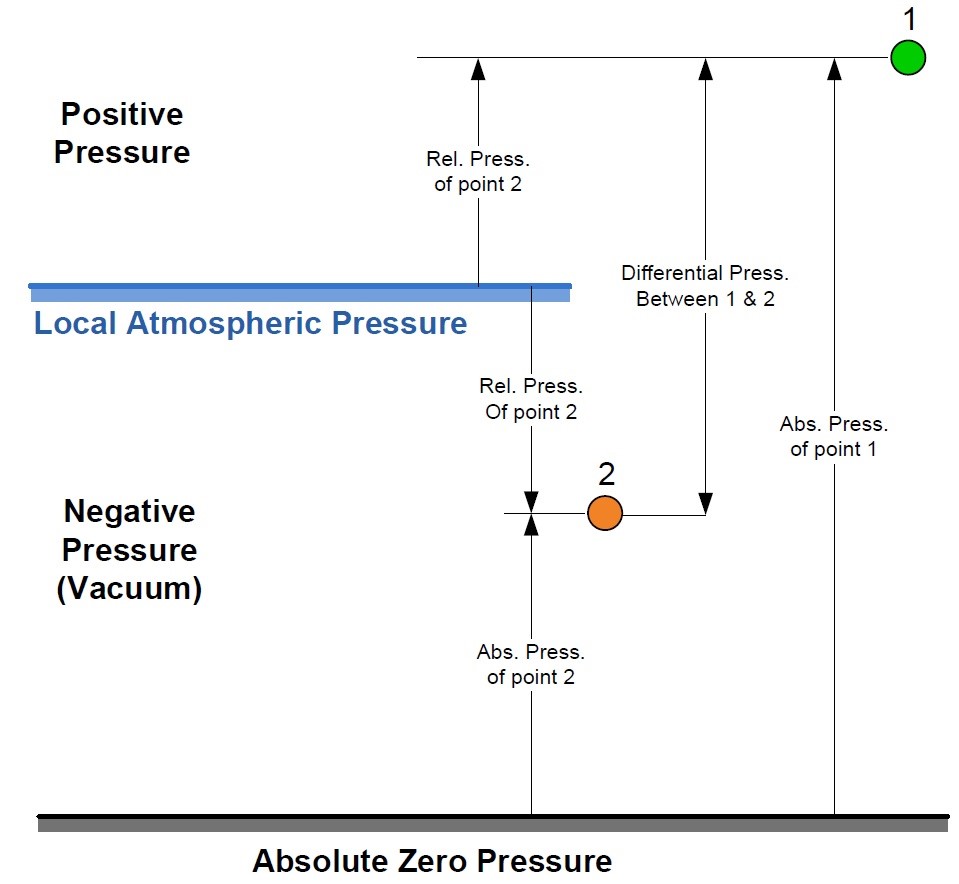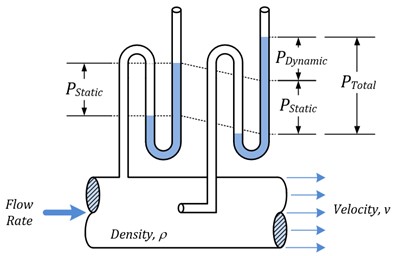When we talk about pressure; immediately, first thing springs to mind is physical definition. It is an effect or various type of deflection when a force pushes or applies on a surface.
It can make different types of deflection on the surface depends on value and applying time. It has many examples and applications such as vehicles tire or a press machine.
The best technique to have a right estimation for applied pressure value is the effect measuring; for example, changes in dimension of an elastic object or height of a liquid column (bellow picture).

Pressure categorized in two main groups: gauge and absolute explained in following diagram.
-
Absolute pressure or absolute zero pressure: It is the naturally minimum possible pressure can be measured in the world; consequently, all measured pressure will be positive in comparison with this point. Absolute zero point achievement is utterly impossible unless by calculation or draw an extremely accurate curve.
-
Gauge pressure or relative pressure: Our body thrives in a constant pressure whole long of our life, named as atmospheric pressure; so we can measure difference of actual pressure and the constant local atmospheric value knows as gauge or relative pressure available in industrial applications easily. It would be better to remind; each measured value between local atmospheric pressure and zero absolute pressure is vacuum; and each measured value higher than local atmospheric pressure is a positive pressure.
There is an equation between absolute and gauge pressure Pabsolute = Patmosphere + Pgauge . Bellow diagram figures out definitions of pressure clearly.

Additionally, there are other interpretations of pressure applicable in flow measurement. The most famous types of pressure are total, static and dynamic pressures.
Total Pressure: It is the force per unit area that is felt when a flowing fluid is brought to rest and is usually measured with a pitot tube type instrument, shown in following figure. The total pressure is the sum of the static pressure and the dynamic pressure.
Ptotal = Pstatic + Pdynamic
Total pressure is often referred to as the stagnation pressure.
Static Pressure: It is felt when the fluid is at rest or when the measurement is taken when traveling along with the fluid flow. It is the force exerted on a fluid particle from all directions, and is typically measured with gauges and transmitters attached to the side of a pipe or tank wall. Since static pressure is what most pressure gauges measure, static pressure is usually what is implied when the term "pressure" is used in discussions.
Dynamic Pressure: The difference between the total and static pressure is the dynamic pressure, which represents the kinetic energy of the flowing fluid. Dynamic pressure is a function of the fluid velocity and its density and can be calculated from
Pdynamic = ρv2 / 2g

Pressure units: SI unit for pressure is Pa (Pascal) equals N/m2 or Newton per square meter. In other dimensional systems, psi (lb/in2) or pound per square inch is applicable but the most famous unit for pressure is bar or mbar. Some of other applicable units and connected equivalents are mentioned bellows:
mbar, bar, kPa, MPa, psi, mm H2O, in H2O, ft H2O, mm Hg, in Hg, g/cm2, kg/cm2, Torr, mTorr, ATM
|
Pa |
bar |
psi |
mbar |
kPa |
Mpa |
mm H2O |
in H2O |
mm Hg |
in Hg |
kgf/cm2 |
Torr |
ATM |
| Pa |
1 |
0.00001 |
0.00015 |
0.01000 |
0.00100 |
0.00000 |
0.1 |
0.00030 |
0.0075 |
0.00030 |
101,972 |
0.00750 |
0.00010 |
| Bar |
100,000 |
1 |
14.50 |
1,000.00 |
100.00 |
0.10000 |
10,197.2 |
401.463 |
750.06 |
29.530 |
1.020 |
750.062 |
0.98692 |
| Psi |
6,894.76 |
0.069 |
1 |
68.948 |
6.895 |
0.007 |
703.1 |
27.680 |
51.715 |
2.036 |
0.07031 |
51.71493 |
0.0680 |
Farbod Tabesh
August - 2019